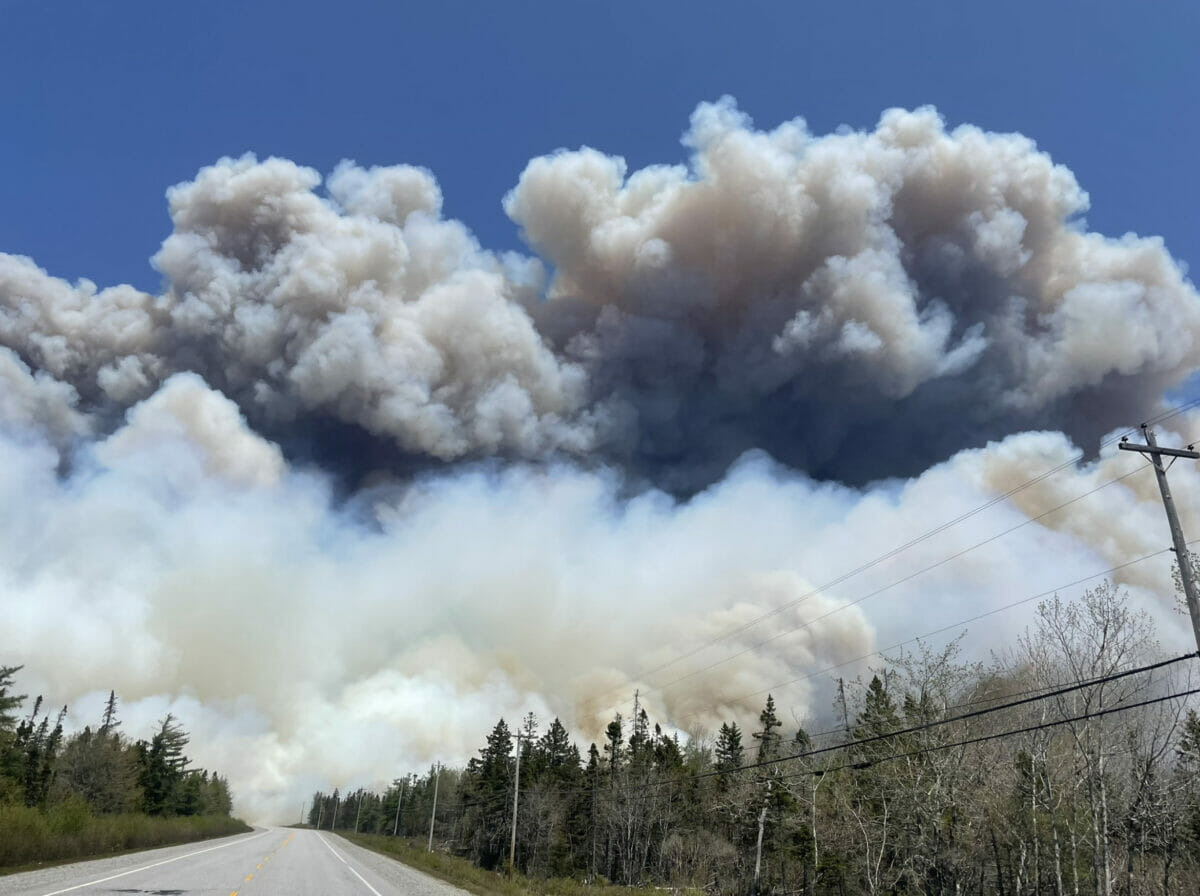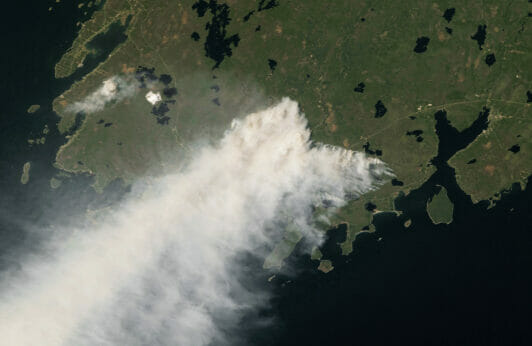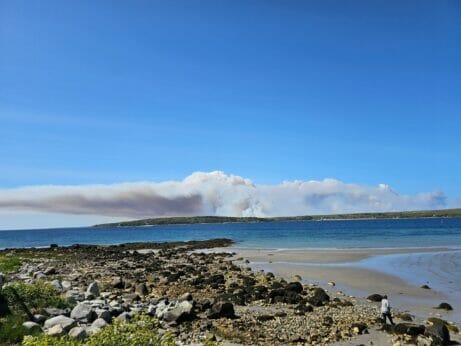Canada’s Wildfires Threaten Its Farmers From All Sides
Falling ash, heavy smoke and black fields: Experts worry that worsening climate conditions will make these destructive wildfires the new normal.
Canada’s Wildfires Threaten Its Farmers From All Sides
Falling ash, heavy smoke and black fields: Experts worry that worsening climate conditions will make these destructive wildfires the new normal.

Smoke from Nova Scotia wildfires poured as far away as Ontario and New Yorkby Twitter @livingbyyyz
When the wildfires descended on his Nova Scotia farm the morning of May 28, Peter Sutherland wasn’t surprised. Drought conditions had turned the land and foliage in Shelburne County—normally lush in late May—to kindling. The fires were all that the locals were talking about for days, and the ashy smoke that billowed across the skies was soon followed by flames visible from Sutherland’s Wild Blueberry U-Pick in Clyde River, along the province’s southwestern tip, two and a half hours from the capital of Halifax. Yet he was still caught off guard when the message came: Evacuate immediately.
“I couldn’t move,” says Sutherland. “If I would have been given 15 minutes,” he trails off.
Sutherland considers himself lucky that he didn’t lose his home, but the fire destroyed a $200,000 harvester, as well as utility tractors, sprayers, a transport trailer and more. All told, Sutherland figures the damage to his equipment to be more than $400,000, and it’s not clear how much the smoke and flames have otherwise damaged his 70 acres. The fires wiped out crops on as much as 20 percent of his 35 active acres, and the pollinating bumblebees from his 40 hives have been ominously absent—a problem that he worries could affect his yields next season.
“All the lands around, just devastated,” says Sutherland. “It’s just black as you can see.”
Sutherland was one of a reported 20 or so farmers and producers affected by the fires in Nova Scotia’s Shelburne County and Halifax Regional Municipality. But countless others across Canada have felt a similar distress in recent weeks. And as farmers can attest, the impacts of a single season can last much longer and spread much wider than one wildfire.

The new normal
According to Alberta’s Ministry of Forestry and Parks, at least 640 wildfires had burned more than 1.4 billion hectares of land in the province through mid-June—already well over its five-year average of 500 fires and previous record of 1.35 million hectares (dating back to 1961). Projections for this year’s wildfire season in Canada have been described by officials as “unprecedented,” with an area nearly the size of New Mexico already having been scorched. As of press time, more than 200 wildfires ranging from British Columbia to Newfoundland and Labrador were still categorized by the Canadian Interagency Forest Fire Centre (CIFFC) as “out of control.”
Climate change experts believe this elevated wildfire threat could represent a new normal. More extreme weather patterns make for harsher drought conditions, even in places such as Canada’s eastern seaboard, which is far less accustomed to wildfire fallout than other areas of the country. When thirsty land is ignited (whether by human hands, high heat or lightning strikes), there is a number of clear and direct threats: compromised air quality, property damage and even death. Earlier this month, nearly 200 homes were damaged or destroyed in wildfires near the Halifax area. In Quebec alone, around 14,000 residents have been evacuated. And in New York and as far away as Iowa, U.S. citizens were being warned of the dangers of the fire’s smoke. But for farmers and producers, those concerns only scratch the surface.
Community efforts
Power outages caused Matthew Roy, owner of Coastal Grove Farm in Upper Port La Tour—located a few miles south of Sutherland’s Wild Blueberry U-Pick in southern Nova Scotia—to scramble for a generator and makeshift water tank in order to maintain delicate conditions in his organic operation’s geothermal greenhouse. Roy and other workers were still hand-watering when the ash began falling around them and the evacuation call came. Displaced from his farm for 11 days, Roy returned to find no fire damage, but the lack of precise moisture and ventilation cost him an estimated $3,500 in tea seedlings.
And the downstream effects are almost incalculable. Some of Roy’s crops that weren’t lost went unsold because of highway closings that cut off routes to buyers. The local farmer’s market was briefly suspended to allow folks in the area to settle back in—another hit to sales. Bringing soil moisture levels back to normal also meant inviting a weed uprising, which Roy would normally tamp down with propane torches. But, hey: wildfires. “These tangential costs are going to creep in here for the way we maintain our systems,” says Roy.
Some of that burden is picked up by the province—Nova Scotia delivered $2,500 emergency grants to its wildfire-affected farmers—and some by insurance carriers. Yet much of the heavy lifting in the moment falls to local systems, community organizations and friendly neighbors.
Roy, who is president of the Yarmouth Shelburne branch of the NSFA, helped ensure farmers and producers in his area received as much support as could be mustered. Working with the greater NSFA and the Nova Scotia Department of Agriculture, Roy and his local NSFA chapter oversaw the opening of several nearby exhibition grounds, where livestock could be transported and cared for. Shifting fire patterns forced some animals to be moved more than once. The logistics just for livestock relocation require a network that would be difficult to co-ordinate in the best of times, let alone with 1,500F° wildfires closing in.
“The rapid-response people need to have trailers available to get in and out of a farm that has 50 sheep that need to be moved or 30 cows to be picked up or 50 horses at a big boarding stable,” says Roy. “It’s coming to awareness—that component has to be there, too, because, right now, that is all done at the local level.”

A Co-ordinated Approach
Moving forward, wildfire emergency responses will require not only well-co-ordinated interagency efforts but, according to Jonathan Eaton, a PhD candidate in anthropology at the University of British Columbia who studies disaster resilience, a multi-hazard approach.
“In the past, and sometimes to a certain extent today, we take each emergency as it comes, each event, and we deal with that,” says Eaton. “But I think, increasingly, there’s an understanding that a single wildfire event doesn’t start when the fire burns and it doesn’t end when the fire goes out. It’s connected to a lot of other hazards.”
As an example, Eaton describes a scenario in which intense wildfire burn in hilly or mountainous areas creates hydrophobic soil conditions, leading to runoff (which may directly affect crop health and yields) and landslide risks (which could threaten thoroughfares and vital travel access). Moreover, this multi-hazard approach dictates that response teams make important choices about “good” and “bad” wildfires. Some burning, after all, is a natural part of a grassland and forest ecosystems, and Eaton points out that wildfire-fighting resources are finite. “As we’ve seen, we haven’t been able to [suppress them all] because, inevitably, the fires get worse and worse as we try to keep all of it from happening.”
The implicit message from experts and government officials to farmers and producers: Prepare for the worst. Because of the number, scale and complexity of factors that fuel wildfires, learning to live with these events is a far more likely outcome than reducing or even mitigating them. The government of British Columbia, for instance, recommends N95 masks for workers exposed to wildfire smoke, and it provides a series of related emergency guides with information about animal health, evacuation orders and climate change adaptation.
Even for Canada’s farmers and producers who escape physical or significant financial turmoil, there is an emotional strain caused by the wildfires that shouldn’t be ignored. Sutherland was displaced from his farm for 14 days—two weeks of wondering and worrying about what was lost and what may be recovered. “You begin to hear a lot of hearsay and gossip,” he says. “It’s just gut wrenching, you know?”
Follow us
This work is licensed under a Creative Commons Attribution-NoDerivatives 4.0 International License.
Want to republish a Modern Farmer story?
We are happy for Modern Farmer stories to be shared, and encourage you to republish our articles for your audience. When doing so, we ask that you follow these guidelines:
Please credit us and our writers
For the author byline, please use “Author Name, Modern Farmer.” At the top of our stories, if on the web, please include this text and link: “This story was originally published by Modern Farmer.”
Please make sure to include a link back to either our home page or the article URL.
At the bottom of the story, please include the following text:
“Modern Farmer is a nonprofit initiative dedicated to raising awareness and catalyzing action at the intersection of food, agriculture, and society. Read more at <link>Modern Farmer</link>.”
Use our widget
We’d like to be able to track our stories, so we ask that if you republish our content, you do so using our widget (located on the left hand side of the article). The HTML code has a built-in tracker that tells us the data and domain where the story was published, as well as view counts.
Check the image requirements
It’s your responsibility to confirm you're licensed to republish images in our articles. Some images, such as those from commercial providers, don't allow their images to be republished without permission or payment. Copyright terms are generally listed in the image caption and attribution. You are welcome to omit our images or substitute with your own. Charts and interactive graphics follow the same rules.
Don’t change too much. Or, ask us first.
Articles must be republished in their entirety. It’s okay to change references to time (“today” to “yesterday”) or location (“Iowa City, IA” to “here”). But please keep everything else the same.
If you feel strongly that a more material edit needs to be made, get in touch with us at [email protected]. We’re happy to discuss it with the original author, but we must have prior approval for changes before publication.
Special cases
Extracts. You may run the first few lines or paragraphs of the article and then say: “Read the full article at Modern Farmer” with a link back to the original article.
Quotes. You may quote authors provided you include a link back to the article URL.
Translations. These require writer approval. To inquire about translation of a Modern Farmer article, contact us at [email protected]
Signed consent / copyright release forms. These are not required, provided you are following these guidelines.
Print. Articles can be republished in print under these same rules, with the exception that you do not need to include the links.
Tag us
When sharing the story on social media, please tag us using the following: - Twitter (@ModFarm) - Facebook (@ModernFarmerMedia) - Instagram (@modfarm)
Use our content respectfully
Modern Farmer is a nonprofit and as such we share our content for free and in good faith in order to reach new audiences. Respectfully,
No selling ads against our stories. It’s okay to put our stories on pages with ads.
Don’t republish our material wholesale, or automatically; you need to select stories to be republished individually.
You have no rights to sell, license, syndicate, or otherwise represent yourself as the authorized owner of our material to any third parties. This means that you cannot actively publish or submit our work for syndication to third party platforms or apps like Apple News or Google News. We understand that publishers cannot fully control when certain third parties automatically summarize or crawl content from publishers’ own sites.
Keep in touch
We want to hear from you if you love Modern Farmer content, have a collaboration idea, or anything else to share. As a nonprofit outlet, we work in service of our community and are always open to comments, feedback, and ideas. Contact us at [email protected].by Jason Langendorf, Modern Farmer
June 24, 2023
Modern Farmer Weekly
Solutions Hub
Innovations, ideas and inspiration. Actionable solutions for a resilient food system.
ExploreShare With Us
We want to hear from Modern Farmer readers who have thoughtful commentary, actionable solutions, or helpful ideas to share.
SubmitNecessary cookies are absolutely essential for the website to function properly. This category only includes cookies that ensures basic functionalities and security features of the website. These cookies do not store any personal information.
Any cookies that may not be particularly necessary for the website to function and are used specifically to collect user personal data via analytics, ads, other embedded contents are termed as non-necessary cookies.